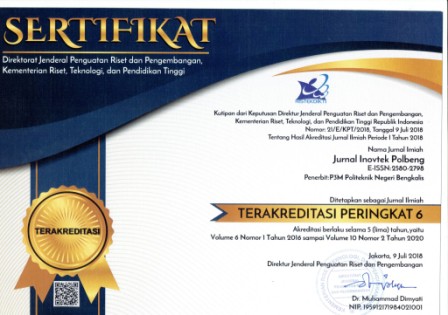Pengaruh Variasi Heat Input pada Pengelasan Dissimillar antara Baja ASTM A36 Dan ASTM A131 Terhadap Tensile Strength dan Struktur Makro
Abstract
In some structural engineering applications, sometimes necessary to weld two different metals, called dissimilar welding. In the shipbuilding process, the method commonly used for dissimilar welding is FCAW (Flux Cored Arc Welding). Due to the difference in material properties between the two welded metals, the quality of the welded joint needs to be studied. Several things affect the mechanical properties of the dissimilar welded joint, one of them is heat input. To evaluate the dissimilar welded joint strength, it is necessary to carry out mechanical testing. Dissimilar welding of ASTM A36 and ASTM A131 steel with three different heat inputs was analyzed experimentally by tensile test and macrostructure observation. The analysis result shows that the yield stress increases when the heat input increases but then decreases when the heat input continues to be increased up to 60 Kj/mm. The opposite result is shown by the ultimate stress value. However, in all heat input conditions at 22 Kj/mm, 52 Kj/mm, and 60 Kj/mm the yield stress and ultimate stress meet the acceptance criteria. In this study, heat input variation has no significant effect on changes in mechanical strength of dissimilar welding results. The macrostructure observations show that the higher the heat input, the wider the Heat Affected Zone (HAZ) area.
Keywords
Full Text:
PDFReferences
W. Chuaiphan, S. Chandra-ambhorn dan S. Niltawach, “Dissimilar Welding between AISI 304 Stainless Steel and AISI 1020 Carbon Steel,†Applied Mechanics and Materials, Vol. %1 dari %2Vols. 268-270, pp. 283-290, 2013.
R. Siswanto, Buku Ajar Teknologi Pengelasan Prodi Teknik Mesin, Universitas Lambung Mangkurat, 2018.
M. W. Ilham, “Analisis Kombinasi Elektroda pada Pengelasan Material Baja dengan Stainless Steel ditinjau dari Sifat Mekanik,†2017.
F. A. Mantika, “Pengaruh Haet Input pada Pengelasan Dissimilar Metal SS304H dan T22 dengan Proses GTAW terhadap Distribusi Kekerasan dan Kandungan Delta Ferrite,†2018.
B. Mvola, P. Kah dan J. Martikainen, “Dissimilar Ferrous Metal Welding Using Advanced Gas Metal Arc Welding Processes,†Rev. Advanced Material Science, vol. 38, pp. 125-137, 2014.
M. Black, “Welding of Dissimilar Metals in Different Welding Positions,†KTH KUNGLIGA TEKNISKA HÖGSKOLAN, 2015.
A. B. a. P. V. Commite, An International Code ASME Boiler & Pressure Vessel Code IX : Qualification Standard for Welding and Brazing Procedures, Welders, Brazers, and Welding and Brazing Operators, The American Society of Mechanical Engineers, 2007.
W. Soedarmadji, “Pengaruh Pengelasan Shielded Metal Arc Welding (SMAW) pada Mild Steel S45C di Daerah HAZ dengan Pengujian Metalografiâ€.
H. Wibowo, M. N. Ilham dan P. T. Iswanto, “Analisa Heat Input Pengelasan terhadap Distorsi, Struktur Mikro dan Kekuatan Mekanis Baja A36,†Jurnal Rekayasa Mesin, vol. 7, no. 1, pp. 5-12, 2016.
V. Romdhoni, Fadelan dan Y. Winardi, “Pengaruh Heat input terhadap hasil kekuatan sambungan pengelasan SMAW pada Material Stainless Steel 201,†Komputek, 2019.
DOI: https://doi.org/10.35314/ip.v12i2.2774
Refbacks
- There are currently no refbacks.
Copyright (c) 2022 INOVTEK POLBENG
This Journal has been listed and indexed in :

inovtek polbeng by http://ejournal.polbeng.ac.id/index.php/IP is licensed under a Creative Commons Attribution-ShareAlike 4.0 International License









